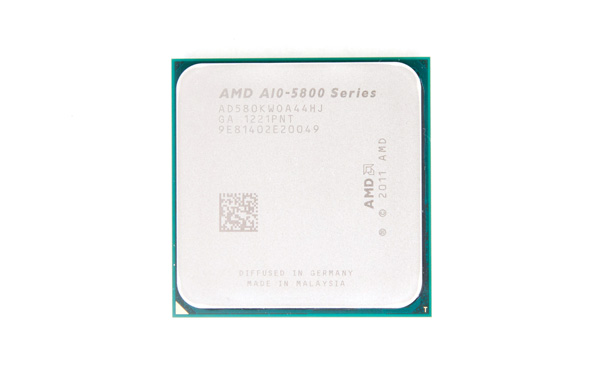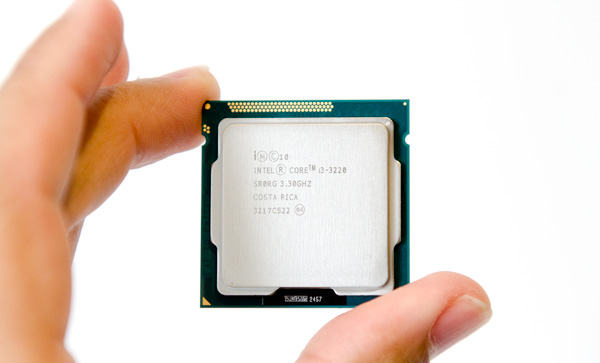AMD A10-5800K & A8-5600K Review: Trinity on the Desktop, Part 2
by Anand Lal Shimpi on October 2, 2012 1:45 AM ESTAlthough AMD's second-generation mainstream APU platform, codename Trinity, launched months ago in notebooks the official desktop launch is today. Rumor has it that AMD purposefully delayed the desktop Trinity launch to clear out unsold Llano inventories in the channel. Although selling APUs in notebooks is pretty easy, convincing desktop users to forgo the discrete GPU option (and ignore Intel) has been a tough battle for AMD. I keep going back to two slides that show us where AMD wants to go and the cores it'll take to get there:

The ultimate goal is this beautiful cohesive operation between CPU and GPU on a single die. That future will require a lot of software support, not only at the application level but also at the OS level. And I'm not talking about Windows 8. We're still far away from this APU dominated future, but AMD is marching in that direction. The second slide shows the x86 cores that we'll see from AMD along the way. AMD is still playing catch-up in the x86 CPU space and it's got a lot of lost time to make up for. There's no hiding the fact this is going to be a multi-year effort to simply get close to Intel's single-threaded x86 performance. Through pricing, leveraging its GPU technology and throwing more transistors at the problem AMD can still deliver competitive solutions, but it's not going to be a walk in the park.
Last week we took a look at the GPU side of the desktop Trinity APUs. We looked at the top end 384-core Radeon HD 7660D configuration as well as the slightly slower 256-core Radeon HD 7560D GPU, both of which easily outperformed Intel's HD 4000 and HD 2500. As far as processor graphics go, Trinity on the desktop maintains a healthy lead over Intel. There's still a place for discrete GPUs but that's pretty much at the $100 and above price points.
Today we're able to talk about pricing and x86 CPU performance among other things. The good news on that front is the most expensive Trinity APU is fully unlocked and is priced at $122:
| AMD Socket-FM2 Lineup | ||||||||
| Modules/Cores | CPU Clock Base/Turbo | L2 Cache | GPU | TDP | Price | |||
| A10-5800K | 2 / 4 | 3.8 / 4.2 GHz | 4MB | 384 cores @ 800MHz | 100W | $122 | ||
| A10-5700 | 2 / 4 | 3.4 / 4.0 GHz | 4MB | 384 cores @ 760MHz | 65W | $122 | ||
| A8-5600K | 2 / 4 | 3.6 / 3.9 GHz | 4MB | 256 cores @ 760MHz | 100W | $101 | ||
| A8-5500 | 2 / 4 | 3.2 / 3.7 GHz | 4MB | 256 cores @ 760MHz | 65W | $101 | ||
| A6-5400K | 1 / 2 | 3.6 / 3.8 GHz | 1MB | 192 cores @ 760MHz | 65W | $67 | ||
| A4-5300 | 1 / 2 | 3.4 / 3.6 GHz | 1MB | 128 cores @ 724MHz | 65W | $53 | ||
| Athlon X4 750K | 2 / 4 | 3.4 / 4.0 GHz | 4MB | N/A | 100W | $81 | ||
| Athlon X4 740 | 2 / 4 | 3.2 / 3.7 GHz | 4MB | N/A | 65W | $71 | ||
Compare this to Llano's launch where the top end SKU launched at $135 and you'll see that AMD is somewhat getting with the times. I would still like to see something closer to $100 for the A10-5800K, but I find that I'm usually asking for a better deal than what most CPU makers are willing to give me.
AMD's competitive target is Intel's newly released Ivy Bridge Core i3 processors. There are only five Core i3s on the market today, four of which use Intel's HD 2500 graphics. The cheapest of the lineup is the Core i3 3220 with two cores running at 3.3GHz for $125. Intel disables turbo and other features (there's effectively no overclocking on these parts), which AMD is attempting to exploit by pitting its Trinity K-series SKUs (fully unlocked) against them. AMD's TDPs are noticeably higher (100W for the higher end K-series parts compared to 55W for the Core i3s). Intel will easily maintain the power advantage as a result under both CPU and GPU load, although AMD's GPU does deliver more performance per watt. Power consumption is a major concern of AMD's at this point. Without a new process node to move to for a while, AMD is hoping to rely on some design tricks to improve things in the future.
At the low end of the stack there are also two Athlon X4s without any active GPU if you just want a traditional Trinity CPU.
The Test
This will be our last CPU/APU review on the current test platform/software configuration. The next major CPU review will see a move to a brand new testbed running Windows 8. As always you can get access to far more numbers than what we report here if you use our performance comparison engine: Bench. Of course if you want to see the GPU and GPU Compute performance of AMD's Trinity APU check out part one of our coverage.
| Motherboard: |
ASUS P8Z68-V Pro (Intel Z68) ASUS Crosshair V Formula (AMD 990FX) Gigabyte GA-F2A85X-UP4 (AMD A85X) Intel DZ77GA-70K (Intel Z77) |
| Hard Disk: |
Intel X25-M SSD (80GB) Crucial RealSSD C300 OCZ Agility 3 (240GB) |
| Memory: | 2 x 4GB G.Skill Ripjaws X DDR3-1600 9-9-9-20 |
| Video Card: |
ATI Radeon HD 5870 (Windows 7) AMD Processor Graphics Intel Processor Graphics |
| Video Drivers: | AMD Catalyst 12.8 |
| Desktop Resolution: | 1920 x 1200 |
| OS: | Windows 7 x64 |













178 Comments
View All Comments
delirious7 - Tuesday, October 2, 2012 - link
also forgot to mention that one ivy bridge pentium has been out for a while now. the G2120. it is retailing for $100 on newegg.bill4 - Tuesday, October 2, 2012 - link
"Can easily upgrade down the line" pretty much misses the point imo.Theoretically, this thing might be for casuals who are never going to upgrade, or people who need to pinch every last penny, or people who want a general purpose machine that isn't a total dog when they wanna game now and again, etc.
LancerVI - Tuesday, October 2, 2012 - link
THIS^^^I agree 100%. Trinity is perfect for a great kids/wife general use computer. Websurfing and minecraft or wizard 101.
As long as they stay off my machine, we're good!
Spunjji - Tuesday, October 2, 2012 - link
Yes, but you shouldn't expect people who didn't even read the conclusion to the article to pay any attention to what you have to say here. :(parkerm35 - Tuesday, October 2, 2012 - link
$70 will get you a nice GT630 which is slower than the 7660D! And then when it comes to threaded tasks, you will be left waiting an eternity. Nice plan....ac2 - Tuesday, October 2, 2012 - link
Actually I said "That puts a $50 saving towards...", I certainly didn't say that would be the total price!Highly threaded integer tasks are a rarity for me so...
CaptainDoug - Tuesday, October 2, 2012 - link
why'd you pick a GT630? there's a 6670 for $65 that's roughly twice as powerful as the GT630. It would end up being like 35% more powerful than a 7660D.Jamahl - Tuesday, October 2, 2012 - link
Did you see how far the Pentium was behind in multi threading? It will not beat the A10 in gaming in most cases but feel free to waste money on a dual core if you want.mattlach - Tuesday, October 2, 2012 - link
Multithreading is still mostly irrelevant in most Games.Yes, there are a couple of games that support it pretty well well (Battlefield 3, Civilization 5) but the vast majority of games out there are still of the "load one core 100% and load a second (and possibly third) core 15-20%" variety.
In these circumstances two fast cores are going to beat 4, 6 or 8 slow cores almost every time.
It's not about IPC, and its not about clock speed. It's about the combination of the two. Per core performance is still king, and I don't think this is going to change any time soon due to the difficulties involved in writing good multithreaded code, and Amdahls law.
( http://en.wikipedia.org/wiki/Amdahls_law )
bji - Tuesday, October 2, 2012 - link
Yeah, but aren't *PC's* irrelevant in most Games?